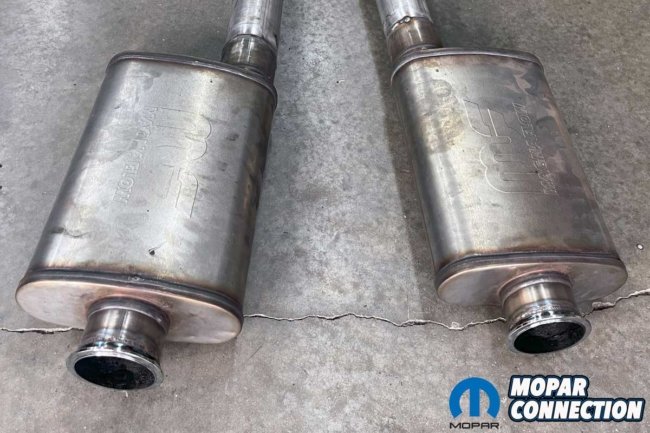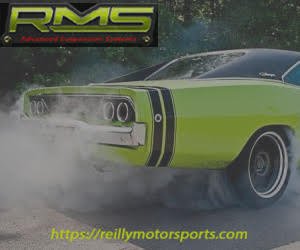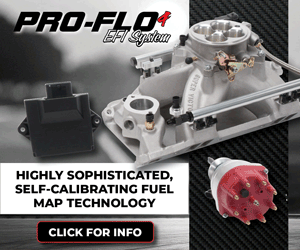
In the fall of 2024, we were thrilled to learn about Sick the Magazine hosting the ‘ultimate road trip,’ Sick 66. The adrenaline-pumping drag-and-drive events, a signature of the Sick group since 2022, involves racers navigating through multiple checkpoints between track events. Each checkpoint is a chance to photograph a moment and submit it the next day, along with the track time slips.
Above Left: For the Sick 66 event, we needed to haul a small trailer loaded with our supplies to complete the journey. We made a custom receiver to fit the ‘Cuda. Above Right: We painted the receiver assembly and installed it on the ‘Cuda. The design of the receiver allows it to be removed without removing the exhaust, valance, fuel tank, or rear suspension.
The process culminates in the thrill of competition at the track all day, followed by the adventure of driving hundreds of miles in a street-legal race car to the next event. Many racers tow trailers behind their car packed with spare tires, tools, parts, fuel, and more components to survive the event. You can bring a co-pilot to help navigate, track day prep, and work on the car.
Above Left: The Cuda would never know the tiny trailer was in tow. Above Right: We made a few test runs with the trailer loaded before we found an adequate arrangement of our supplies for the best weight distribution.
We were thrilled to plan our participation in the Sick 66 event, a significant milestone in the drag-and-drive community. Scheduled for October 10th-18th, 2024, the event would take us through a thrilling route spanning Missouri, Oklahoma, Texas, and New Mexico. With Edelbrock as the title sponsor, the event was masterminded by Tom Bailey, the visionary founder of Sick the Magazine. The event would feature six eighth-mile racing events, each connected by the iconic Route 66.
The event, spanning over 1300 miles, with 30+ checkpoints ranging from abandoned gas stations to iconic Route 66 sights, is a unique and one-time-only experience. Like the legendary ‘Death Week’ the year before, Sick 66 promised to be an event never to be repeated.
Above Left: We added a Gear Vendors overdrive unit to lower the engine RPM when cruising. It involved plenty of work to install, but it was well worth it. Above Right: We adjusted the exhaust to fit the overdrive unit.
Our journey to the Sick 66 event began with the opening of registrations on March 2, 2024. Like many other enthusiasts, we eagerly signed up for the event. The excitement only grew when the recommended hotel list was released, prompting our group to meticulously plan our stay. We chose to follow the recommended hotel list, knowing that each host hotel would provide unique evening entertainment, adding to the overall experience.
We planned to compete in our 1973 ‘Cuda. Our adventure would start by cruising from our home in Nashville, Tennessee, to the event starting point in Springfield, Missouri. The event would end in Roswell, New Mexico. With the ride to the event, the journey, and then the return home, we were expected to roll at least 3000 miles on the odometer and even more with all six days of eighth-mile racing.
Above Left: We added a taller pair of rear tires to reduce the cruising engine RPM even more. Above Right: The ‘Cuda had the perfect stance with the new rear tires. With the overdrive and the tall tires, the ‘Cuda cruised at a comfortable engine RPM.
Our ‘Cuda was not running when we registered, but we knew the engine would be completed in April (2024). As veterans of a few drag-and-drive events, we had a good idea of what improvements we needed to complete before the event. Between April and October, we had an additional full-time job upgrading the car for performance, reliability, and comfort. We planned to attend the Hot Rod Power Tour in June for a shake-down trip to iron out the combination.
We completed the Hot Rod Power Tour without any problems. However, the Power Tour was merely a cruise—no racing required. Also, we did not trek too far from home on the tour. Upon our return, we knuckled down and prepped the ‘Cuda for the long haul and racing.
Above Left: To meet the requirements of NHRA tech inspection, we added a universal driveshaft loop that we modified to fit the driveshaft tunnel and clear the overdrive unit. Above Center: We added a master cutoff switch, which disconnected the B+ cable and the alternator field simultaneously to shut off the engine. Above Right: We moved the fuel regulator further forward in the engine bay to meet the NHRA regulations.
First, we installed a trailer hitch on the ‘Cuda. We enlisted WAF Racing to 3D scan the underside of the ‘Cuda and design a custom receiver. It was an interference-free installation, so we could continue to use the factory-routed exhaust, fuel tank, suspension, and rear valance. We tapped into the rear lighting harness with a generic 4-pin trailer wire kit and installed a zip-tie magnet to the 4-pin harness so it could be clipped behind the valance when not in use.
We survived the Hot Rod Power Tour with no overdrive and 3.55 gears in the rear. Running 65-70 mph with that setup was doable, but a higher engine RPM than we preferred. With the expectation of a more extended cruise and speeds that may be faster than the Power Tour, we added a Gear Vendors overdrive with a 0.78:1 overdrive.
Above Left: To make the most consistent runs on the track, we added a shift light to indicate when we needed to upshift. Above Right: Additionally, we added a line lock into the brake system. Being able to lock the front brakes afforded better control of our burnouts.
The drag-and-drive events require an NHRA Tech inspection. A driveshaft loop is a requirement for any car running drag radials or slicks. Due to the location of the Gear Vendors overdrive, we could not buy a bolt-on loop that mounts to the transmission cross member. So, we opted for a budget-friendly generic piece and modified it to fit.
Because we moved the battery to the trunk, NHRA tech requires an externally mounted shutoff switch on the car’s rear. We opted for a Moroso unit with the push/pull rod that extended through a small hole we drilled through the trunk. We installed a 4-lug unit, so the B+ cable and alternator’s field are broken simultaneously.
Above Left: We added the tried-and-true Mopar Super Stock springs to the rear of the ‘Cuda. The spring hangers were also replaced. Above Right: At the front, we added a pair of cryogenically treated 0.900-inch torsion bars, which provided a great ride while allowing excellent weight transfer at the track.
Yet another tech concern was the placement of our fuel regulator. We decided to move the regulator forward in the engine bay. Also, we plumbed the system with an “AN” braided line from the tank to the carburetor.
We plumbed a Hurst line lock kit into the brake system for on-track consistency and wired it to a button on the shifter T-handle. We used an AutoMeter Level 1 Digital Pro Shift Controller (part no. 5312) and an externally mounted shift light on the dash, which included a bright yellow shift light.

Above: We used a 3D scanner to develop an image of the chassis of the ‘Cuda. From the scan, we developed a pair of custom frame connectors.
Moving to the chassis, we swapped a pair of Super Stock springs we got from Summit Racing and front hangers from Mancini Racing. Up front, we replaced the original factory torsion bars with a set of cryogenically treated 0.90-inch diameter (part nos. 779L & 778R) from Nitro 300 Xtreme Finishing. To stiffen the chassis, we used WAF Racing resources to scan the chassis so we could design, build, and install our subframe connectors.
We survived the Hot Rod Power Tour with an ECP brand aluminum radiator and Flex-A-Lite nylon fan, but we lacked confidence in our setup. Therefore, we opted for a Wizard Cooling 26-inch radiator and modified the ‘Cuda’s radiator support to take full advantage of the larger radiator surface. We also mounted dual Spal electric fans discarded from Mopar Connection Magazine’s Brazen Charger. Again, we employed WAF Racing to design, build, and install a chin spoiler to direct a maximum air volume toward the new radiator.
Above Left: We added a dual Spal electric fan assembly to the ‘Cuda. They were castoffs from Mopar Connection Magazine’s Brazen Charger. We developed extensive ducting and shrouding to channel the air flowing through the radiator. Above Right: Because our ‘Cuda had increased electrical demands due to added electrical accessories, we added a Mopar 100-amp Proform one-wire alternator.
We added electric fans to the previously taxed electrical system, which already had headlights, taillights, trailer lights, a stereo, a blower motor, and an electric fuel pump. We installed an officially licensed Mopar 100-amp Proform one-wire alternator to fix our electrical system challenges.
The 8 ¾-inch rear end was decent, but we needed more strength and desired to change the gear ratio. We installed a fabricated Moser MO875 rear end under the ‘Cuda. The Musclepak rear end was a perfect choice. [You’ll want to click this link to read the story on building this killer unit and watch the video as we were there to document the whole process. –Ed.]

Above: We added a fabricated Moser MO875 rear end. It came complete with the housing, gears, and drum brakes.
We opted to convert to manual brakes to save weight and free up some space. A Doctor Diff kit provided most of the components. The conversion shed over fourteen pounds from the car. Manual brakes provided a normal-feeling pedal regardless of the engine’s operation.

Above Left: The factory brake booster and master cylinder were heavy and took up substantial space in the engine bay. Above Right: We removed the power booster and swapped the master cylinder to an aluminum and plastic piece. The weight reduction was substantial, and we enjoyed the extra room in the engine bay.
Cupholders would be required for our 3000-mile trip. Yet again, we used WAF Racing resources to 3D scan the factory console to design a pair of cup holders (driver and passenger). If you have an E-body with a console and are interested in cup holders, visit the WAF Racing website for more information.
We wanted a bank of toggle switches to control the electric fans, Gear Vendors overdrive, fuel pump, dome light, and roll control. Toggle-switched LED halo lights illuminated around the switches when driving at night. The panel that housed the switches and halo lights was 3D printed.
Above Left: We needed cup holders in the ‘Cuda. We again used a 3D scanner to help develop a usable location for the holders. Above Center: From the 3D scan to reality, the cup holders worked perfectly. Above Right: A 3D-printed panel houses multiple switches and illumination halos.
Lastly, we did some maintenance on the ‘Cuda. Because the brake pedal felt spongy and we were worried about the caliper seals, we swapped the calipers with remanufactured units from Napa. It was inexpensive and easy, and it gave us peace of mind.
We double-checked our pinion angle after installing the Super Stock springs and Gear Vendors overdrive. Several racers suggested a 4° down pinion angle from the driveshaft angle, so that is where we set it as a starting point. Summit Racing provided several different degree shim options. We selected what we needed and put the rest in our trailer if we wanted to make additional adjustments.
Above Left: The pinion angle was adjusted with shims between the leaf spring and perch on the axle housing. Above Center: We added a pair of new calipers to ensure the brake pedal was firm during our events. Above Right: After adding the torsion bars and Super Stock springs and adjusting the pinion angle, we aligned the ‘Cuda to take advantage of the new suspension and radial tires.
Because our side mirrors were loose, we contacted MegaPartsUSA for a new pair. After our torsion bar upgrade, we required a front-end alignment. The SPC adjustable upper control arms and QA1 adjustable steering struts allowed the alignment angles to fall into spec easily. After the suspension alignment, we performed a headlight alignment to re-aim each beam.
Above Left: We repaired the trunk latch after it failed during the Hot Rod Power Tour. Above Right: The maintenance of the engine included changing the oil. We selected Driven GP-1 oil to handle the lubrication of the engine.
The trunk latch key rod mechanism broke during the Hot Rod Power Tour. We did an “on-the-fly” repair during the Power Tour. A new latch key rod was picked up from MegaPartsUSA. The parts fit perfectly. Fixing the driver’s side door handle was not planned, but the handle broke off one week before the event. AMD saved the day by rushing us a new handle.
As the day to leave quickly approached, we changed the engine oil. We also replaced the coolant with water and additives, so the ‘Cuda was legal for on-track racing. The transmission fluid was still in good shape, and the Gear Vendors oil and Moser differential fluid were fresh from the recent installations.
Above Left: We cleaned the fuel filters as part of the maintenance before the Sick 66 event. Above Right: We broke the external door handle just days before the event. We were able to install an aftermarket handle before we left for Missouri.
The ‘Cuda’s fuel filters had been on for a few thousand miles, so we pulled them apart, cleaned them with compressed air, and reinstalled them. We designed the filtration system to utilize a 100-micron filter at the inlet of the Holley Blue pump and a 40-micron filter at the outlet.

Above: Our list of additions, repairs, and maintenance was extensive, but we completed each task listed and marked them off our dry-erase board.
Based on our previous experiences, recommendations from friends, track goals, cruising comfortability, and NHRA rules, we ended up with a massive “to-do” list. Making the event was challenging as we worked on the ‘Cuda until the evening before we had to leave. Unfortunately, a stripped thread on our Holley 830 had us thrashing, but we made the event.
Join us next month; we will cover the ‘Cuda’s adventures at the Sick 66 event.

































































